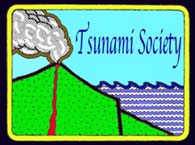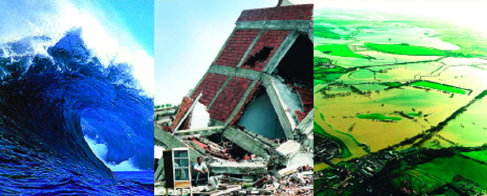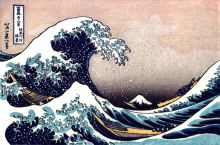AWARDS
IN RECOGNITION OF OUTSTANDING AND ORIGINAL CONTRIBUTIONS TO THE SCIENCE OF TSUNAMI HAZARDS
The following are the scientists who received Tsunami Society International's 2012 Awards at the 5th International Tsunami Symposium at the European Commission's Joint Research Centre in Ispra, Italy
------------------------
AWARDED 2012
At the 5th International Tsunami Symposium at the European Commision's Joint Research Centre, in Ispra, Italy
Dr. Charles L. Mader
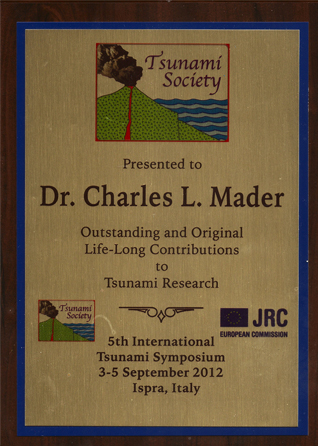
Dr. Charles L. Mader was presented by Dr. George Pararas-Carayannis with the Tsunami Society International life-long award for his research work at the U.S. Los Alamos Scientific Laboratory, his close co-operation on tsunami research with scientists at the University of Hawaii, for his publication of books entitled "Numerical Modeling of Detonations" and the two editions of "Numerical Modeling of Water Waves" - the latter pertaining on what is being done with state-of-the-art, high-performance computers which allow for rapid solution of highly complex Navier-Stokes and other equations that describe wave generation, wave energy propagation, as well as the adaptation of new codes that can result in accurate simulations of waves generated from a variety of source mechanisms - whether earthquakes, landslides, explosions, or the impact of asteroids.
Dr. Pararas-Carayannis made a detailled introduction of Dr. Mader's research work and gave a brief review of his books on numerical modelling and their value to the scientific community (see his introduction below). Also, Prof. Tad Murty of the University of Ottawa (Vice-President of Tsunami Society International) made additional comments and accepted the award on behalf of Dr. Mader (who was unable to attend the Symposium).
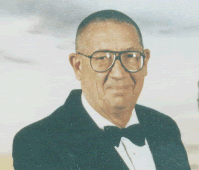
DR. CHARLES L. MADER
Tsunami Society International’s honoree is Dr. Charles L. Mader, whom most of you know – but who unfortunately could not attend our Symposium this time. Personally I have known Dr. Charles Mader since the early sixties when he was at the Los Alamos National Laboratory but also a frequent visitor to Hawaii where he interacted with our group of scientists at the Joint Tsunami Research Effort, at the Institute of Geophysics of the University of Hawaii.
Dr. Mader attended the Oklahoma City University and the University of Kansas. He became a staff member of the Los Alamos Scientific Laboratory in 1955 where he worked until his retirement in 1986. However, he continued consulting at the laboratory until 2005. He was a Fellow of the American Institute of Chemists, recipient of the Los Alamos Distinguished Performance Award, and was the organizer and first Co-ordinator of the Los Alamos Fellows. He was listed in Who's Who in the World and in America. He was a member of the National Academies' Technical Assessment Board Panel on Armor and Armaments.
After his retirement he became president of Mader Consulting Co. and did numerical modeling and consulting work for Government and Industrial organizations on Explosives, Propellents, and Tsunami Waves. He also served as editor of our journal SCIENCE OF TSUNAMI HAZARDS which he also archived at the Los Alamos National Laboratory.
But in addition to his academic achievements and consulting work Dr. Charles Mader was an avid mountain climber and skier. In 1959 he became the 65th mountain climber to have climbed the 54 Colorado peaks above 14,000 feet and climbed 95 of the 100 highest Colorado mountains. He also climbed Monta Rosa and the Matterhorn among other Swiss mountains. He and his wife, Emma Jean, skied together for over 50 years at ski areas from New Zealand to Alaska including the Tasman glacier and heliskied in Canada. But it is not for his outstanding climbing and skiing skills that we honor him today, but for his contributions to tsunami research.
Dr. Mader’s first book entitled Numerical Modeling of Detonations, was followed by "Numerical Modeling of Explosives and Propellants" published in 1998 and a later edition in 2008.
He published Numerical Modeling of Water Waves, Second Edition in 2004 with a CD-ROM of his computer codes of numerical methods for solving water wave problems, computer animations and PowerPoints of tsunami models that have been solved.
In my review of the second edition of this book, I noted specifically that it was a well-written, comprehensive treatise on what is being done with state-of-the-art, high-performance computers which allow for the adaptation of new codes that can result in accurate simulations of waves generated from a variety of source mechanisms - whether earthquakes, landslides, explosions, or the impact of asteroids.
Furthermore, I commented on the inclusion in the book of important theoretical principles of water wave theory and the governing mathematical equations of Eulerian conservation of mass, momentum and energy which are used to describe different forms of water waves. Also, I commented of his development of codes for specific applications to computer modeling - new codes which allow for rapid solution of highly complex Navier-Stokes and other equations that describe wave generation, wave energy propagation and which allow the prediction of near and far field wave characteristics from different sources and the effects on the distribution of wave energy and its attenuation across a body of water – based on refined rectangular meshes and finite difference schemes. In fact, his model – with my input parameters of tsunamigenic source – was used in a recent joint study and publication of the impact of the 365 AD tsunami in the Eastern Mediterranean. In summary, the Second Edition of Numerical Modeling of Water Waves by Dr. Charles Mader represents an outstanding work of scholarship and a valuable reference for any researcher involved in numerical modeling of waves.
In brief Dr. Charles Mader’s outstanding work over a 50 year period is widely recognized, so it is my pleasure to present him – even in absentia - the Tsunami Society International’s award for outstanding, LIFE-LONG CONTRIBUTIONS to tsunami research and ask Dr. Tad Murty to accept it on his behalf.
______________________________________________
Dr. Alessandro Annunziato
Dr. Alessandro Annunziato was presented by Dr. Pararas-Carayannis the award of Tsunami Society International for his work on Nuclear Engineering and more specifically on the Design Basis Accident Analysis of reactors and Fuel Coolant Interaction in case of Severe Accidents, as well as his involvement at the European Commission's Joint Research Centre (EC-JRC) in Ispra, Italy, in the development of Crisis Management Technologies and Tools and all the automatic procedures for the analysis of Tsunamis in real time that is currently in use at the Crisis Room of EC-JRC.
Dr. Pararas-Carayannis made the following introduction of Dr. Annunziato's research work that qualified him for the award of the Society.
DR. ALESSANDRO ANNUNZIATO
Dr. Alessandro Annunziato, graduated Laurea cum Laude in Nuclear Engineering from Rome University. In the first part of his career he was involved in thermal-hydraulics applied to Nuclear Reactor Safety Engineering problems. He was involved in two important projects at the Joint Research Centre, the LOBI project, dedicated to the Design Basis Accident Analysis of reactors and the FARO project, dedicated to the Fuel Coolant Interaction in case of Severe Accidents. In the frame of the Fuel Coolant Interaction he developed the COMETA code for the study of the progression of the energetic interaction between molten Uranium fuel and the water, which may determine, under certain conditions a Steam Explosion. This is a low probability unlikely phenomenon that became sadly real during the Fukushima Accident and constitutes a link with the second part of Dr. Annunziato’s activities.
In the second part of his activities he was involved in the development of Crisis Management Technologies and Tools leading the group that developed the Global Disasters Alerts and Coordination System (GDACS). In this framework he developed all the automatic procedures for the analysis of Tsunamis in real time that is currently in use in GDACS; he also developed other useful tools for the analysis of ongoing events (TAT, Tsunami Analysis Tool) and a physical device for alerting population at risk on the beaches (TAD, Tsunami Alerting Device). In addition Dr. Anunziato is responsible for the European Crisis Management Laboratory (ECML) that you visited this afternoon and which is dedicated to the testing of new solutions for Management of Crises, including Tsunami events which play an important role.
Dr. Anunziato joined Tsunami Society International in 2007 and has published some of his work in SCIENCE OF TSUNAMI HAZARDS. His latest contribution was in March 2012 and was included in the latest issue of the Journal. His paper, entitled “Sea Level Signal Correction for the 2011 Tohoku tsunami” includes unique analyses of the signals measured during the M9.0+ Tohoku Tsunami in order to identify the effect of the subsidence on the measurements and to determine correction factors to be applied to the measurements. His methodology leads to a coherent set of measurements that can allow the correct estimation of the source term for this Tohoku event through inversion techniques.
Although a nuclear engineer by training, through his latest work and research at EC-JRC Dr. Annunziato has also become an outstanding tsunami expert. Thus, it gives me great pleasure to present Dr. Alessandro Annunziato with Tsunami Society International’s award for Outstanding and Original Contributions to Tsunami Research.
________________________
Prof. Barbara Theilen-Willige
Dr. Barbara Thielen-Willige was presented by Dr. Pararas-Carayannis with the award of Tsunami Society International for her work at Berlin University of Technology, Institute of Applied Geosciences and at the Bureau of Applied Geoscientific Remote Sensing in Germany, in the fields of GeoInformation Systems (GIS) and the integrated geomorphologic and geologic evaluation of satellite imageries and aerial photographs. More specifically, for her use of GIS integrated geo-scientific evaluation of remote sensing data and the use of weighted overlay methods in ArcGIS for the detection of areas susceptible to tsunami flooding due to their morphometric properties.
Prof. Tad Murty, (Vice-Prsident of the Society) made the introduction about Prof. Thielen- Willige outstanding work on remote sensing methodology as a tool in tsunami research.
Prof. BARBARA THEILEN-WILLIGE
Dr. Barbara Thielen-Willige is professor at Berlin University of Technology, Institute of Applied Geosciences and an outstanding researcher at the Bureau of Applied Geoscientific Remote Sensing in Germany.
She attended the Technical Universities of Hannover, Clausthal and Berlin and has a degree in Geography and a doctoral degree in Geology. Additionally, she received grants by the German Academic Exchange Service for scientific geologic research in Brazil as well as a grant by the German Research Foundation (DFG) in Bonn – the latter being a private enterprise founded in 1986, where she also serves as consultant in the fields of geoscientific remote sensing.
Dr. Thielen-Willige has done extensive research in Geology, Geography, Geographical Information Systems, Remote Sensing and Natural Hazard Research. She has many years of experience in the fields of GeoInformation Systems (GIS) integrated geomorphologic and geologic evaluation of satellite imageries and aerial photographs
Specifically, she used such GIS integrated geo-scientific evaluation of remote sensing data for the detection of areas exposed to natural hazards. In addition to the assessment of earthquake damage due to local site conditions and of earthquake induced secondary effects such as mass movements. One focus in the last few years was tsunami research, especially the use of weighted overlay methods in ArcGIS for the detection of areas susceptible to tsunami flooding due to their morphometric properties.
Finally, Dr. Brbara Thielen has published extensively papers in several scientific journals and particularly in our journal “Science of Tsunami Hazards”. Thus, recognizing her pioneering work in remote sensing being a tool for tsunami evaluation, the Tsunami Society International is granting her an award for her continuous and outstanding work in Tsunami Research.
____________________________________________
Prof. Tomoya Shibayama
Dr. Tomoya Shibayama was presented by Dr. George Pararas-Carayannis with the award of Tsunami Society International for his outstanding research work in Civil, Environmental and coastal Engineering at Waseda University in Tokyo and as Director of the Composed Crisis Institute, for his thorough evaluation of the 2011 Tohoku tsunami disaster with emphasis on future coastal protection that will help mitigate the impact of tsunamis in Japan.
Prof. Ioan Nistor (middle of photo) made the introduction of Prof. Shibayama's outstanding work in coastal engineering and on the 2011 Tsunami Disaster in Japan.
____________________________________________
Prof. Dan Palermo
Dr. Dan Palermo was presented by Dr. George Pararas-Carayannis with the award of Tsunami Society International for his engineering research work at the University of Ottawa on tsunami loads on infrastructure facilities and on experimental and numerical modelling of tsunami-induced hydrodynamic forces on structures.
Prof. Ioan Nistor (in the background) made the introduction of Prof. Palermo's outstanding work on experimental and numerical modelling of tsunami-induced hydrodynamic forces on structures.
_______________________________________________
Prof. Efim Pelinovsky
Professor Efim Pelinovsky was presented by Dr. George Pararas-Carayannis with the award of Tsunami Society International for his research work on fluid dynamics with emphasis on tsunamis, at the Nizhny Novgorod State University, the Institute of Applied Physics of the Russian Academy of Sciences in Novgorod, as well for his research at the State Technical University and at the Higher School of Economics.
Prof. Tad Murty, (Vice-Prsident of the Society) made the introduction about Prof. Efim Pelinovsky's outstanding work on fluid mechanics and tsunamis in Russia and abroad.
Prof. EFIM PELINOVSKY
Pofessor Efim Pelinovsky graduated from Gorky State University (now called Nizhny Novgorod State University) with "red" (meaning best) diploma in Quantum Electronics (equivalent of an Ms degree during the Soviet time) in 1969, and then a PhD in Radiophysics (Oscillations and Waves) in 1972 at the same University. Subsequently he worked at the then called Institute of Scientific Research Radiophysics, then (from 1977 on) renamed as the Institute of Applied Physics. Parallel past teaching positions were that of Professor at the State Technical University (from 1984) and then the Higher School of Economics (from 2010).
Also Professor Pelinovsky was visiting Professor teaching Fluid Mechanics (from 3 to 10 months) in Haifa, Israel (1993/1994), in Melbourne, Australia (1995-1999), in Marseille, France (1999-2003), and in Guadeloupe (2002-2010), UK (2008). Presently he is with the Department of Nonlinear Geophysical Processes of the Institute of Applied Physics, of the Russian Academy of Sciences in Novgorod. His work on fluid dynamics with emphasis on tsunamis has been exceptional, which Tsunami Society International recognizes by granting him an award for outstanding and continuous contributions to Tsunami Research.
------------------------
SCIENCE OF
TSUNAMI HAZARDS
The International Journal of The Tsunami Society
ISSN 8755-6839
